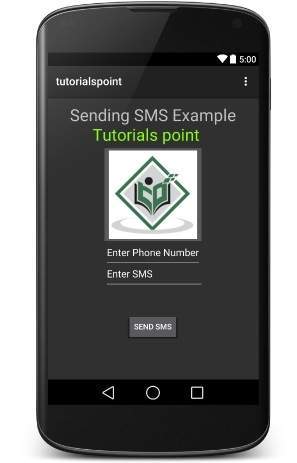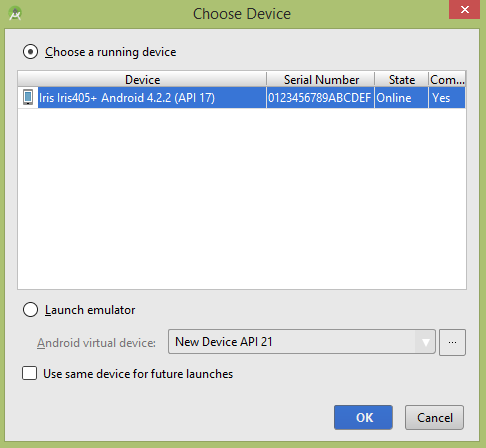Android-SMS 보내기
Android에서는 SmsManager API 또는 장치 내장 SMS 애플리케이션을 사용하여 SMS를 보낼 수 있습니다. 이 튜토리얼에서는 SMS 메시지를 보내는 두 가지 기본 예를 보여줍니다.
SmsManager API
SmsManager smsManager = SmsManager.getDefault();
smsManager.sendTextMessage("phoneNo", null, "sms message", null, null);Built-in SMS application
Intent sendIntent = new Intent(Intent.ACTION_VIEW);
sendIntent.putExtra("sms_body", "default content");
sendIntent.setType("vnd.android-dir/mms-sms");
startActivity(sendIntent);물론 둘 다 필요 SEND_SMS permission.
<uses-permission android:name="android.permission.SEND_SMS" />위의 방법 외에도 SmsManager 클래스에서 사용할 수있는 다른 중요한 기능은 거의 없습니다. 이러한 방법은 다음과 같습니다.
| Sr. 아니. | 방법 및 설명 |
|---|---|
| 1 | ArrayList<String> divideMessage(String text) 이 방법은 메시지 텍스트를 최대 SMS 메시지 크기보다 크지 않은 여러 조각으로 나눕니다. |
| 2 | static SmsManager getDefault() 이 메서드는 SmsManager의 기본 인스턴스를 가져 오는 데 사용됩니다. |
| 삼 | void sendDataMessage(String destinationAddress, String scAddress, short destinationPort, byte[] data, PendingIntent sentIntent, PendingIntent deliveryIntent) 이 방법은 데이터 기반 SMS를 특정 응용 프로그램 포트로 보내는 데 사용됩니다. |
| 4 | void sendMultipartTextMessage(String destinationAddress, String scAddress, ArrayList<String> parts, ArrayList<PendingIntent> sentIntents, ArrayList<PendingIntent> deliveryIntents) 여러 부분으로 된 텍스트 기반 SMS를 보냅니다. |
| 5 | void sendTextMessage(String destinationAddress, String scAddress, String text, PendingIntent sentIntent, PendingIntent deliveryIntent) 문자 기반 SMS를 보냅니다. |
예
다음 예제는 SmsManager 개체를 사용하여 주어진 휴대폰 번호로 SMS를 보내는 방법을 보여줍니다.
이 예제를 실험하려면 최신 Android OS가 장착 된 실제 모바일 장치가 필요합니다. 그렇지 않으면 작동하지 않을 수있는 에뮬레이터와 씨름해야합니다.
| 단계 | 기술 |
|---|---|
| 1 | Android Studio IDE를 사용하여 Android 애플리케이션을 만들고 com.example.tutorialspoint 패키지 아래에 tutorialspoint 로 이름을 지정합니다 . |
| 2 | src / MainActivity.java 파일을 수정 하고 SMS 전송을 처리하는 데 필요한 코드를 추가합니다. |
| 삼 | 레이아웃 XML 파일 res / layout / activity_main.xml 수정 필요한 경우 GUI 구성 요소를 추가하십시오. 휴대폰 번호와 SMS 문자를 보낼 수있는 간단한 GUI와 SMS를 보낼 수있는 간단한 버튼을 추가하고 있습니다. |
| 4 | res / values / strings.xml에서 기본 문자열 상수를 정의 할 필요가 없습니다. Android 스튜디오는 기본 상수를 처리합니다. |
| 5 | 아래와 같이 AndroidManifest.xml 을 수정 합니다. |
| 6 | 애플리케이션을 실행하여 Android 에뮬레이터를 시작하고 애플리케이션에서 수행 한 변경 결과를 확인합니다. |
다음은 수정 된 주요 활동 파일의 내용입니다. src/com.example.tutorialspoint/MainActivity.java.
package com.example.tutorialspoint;
import android.Manifest;
import android.content.pm.PackageManager;
import android.os.Bundle;
import android.app.Activity;
import android.support.v4.app.ActivityCompat;
import android.support.v4.content.ContextCompat;
import android.telephony.SmsManager;
import android.util.Log;
import android.view.Menu;
import android.view.View;
import android.widget.Button;
import android.widget.EditText;
import android.widget.Toast;
public class MainActivity extends Activity {
private static final int MY_PERMISSIONS_REQUEST_SEND_SMS =0 ;
Button sendBtn;
EditText txtphoneNo;
EditText txtMessage;
String phoneNo;
String message;
@Override
protected void onCreate(Bundle savedInstanceState) {
super.onCreate(savedInstanceState);
setContentView(R.layout.activity_main);
sendBtn = (Button) findViewById(R.id.btnSendSMS);
txtphoneNo = (EditText) findViewById(R.id.editText);
txtMessage = (EditText) findViewById(R.id.editText2);
sendBtn.setOnClickListener(new View.OnClickListener() {
public void onClick(View view) {
sendSMSMessage();
}
});
}
protected void sendSMSMessage() {
phoneNo = txtphoneNo.getText().toString();
message = txtMessage.getText().toString();
if (ContextCompat.checkSelfPermission(this,
Manifest.permission.SEND_SMS)
!= PackageManager.PERMISSION_GRANTED) {
if (ActivityCompat.shouldShowRequestPermissionRationale(this,
Manifest.permission.SEND_SMS)) {
} else {
ActivityCompat.requestPermissions(this,
new String[]{Manifest.permission.SEND_SMS},
MY_PERMISSIONS_REQUEST_SEND_SMS);
}
}
}
@Override
public void onRequestPermissionsResult(int requestCode,String permissions[], int[] grantResults) {
switch (requestCode) {
case MY_PERMISSIONS_REQUEST_SEND_SMS: {
if (grantResults.length > 0
&& grantResults[0] == PackageManager.PERMISSION_GRANTED) {
SmsManager smsManager = SmsManager.getDefault();
smsManager.sendTextMessage(phoneNo, null, message, null, null);
Toast.makeText(getApplicationContext(), "SMS sent.",
Toast.LENGTH_LONG).show();
} else {
Toast.makeText(getApplicationContext(),
"SMS faild, please try again.", Toast.LENGTH_LONG).show();
return;
}
}
}
}
}다음 내용은 res/layout/activity_main.xml 파일-
여기서 abc는 tutorialspoint 로고에 대해 나타냅니다.
<?xml version="1.0" encoding="utf-8"?>
<RelativeLayout xmlns:android="http://schemas.android.com/apk/res/android"
xmlns:tools="http://schemas.android.com/tools"
android:layout_width="match_parent"
android:layout_height="match_parent"
android:paddingBottom="@dimen/activity_vertical_margin"
android:paddingLeft="@dimen/activity_horizontal_margin"
android:paddingRight="@dimen/activity_horizontal_margin"
android:paddingTop="@dimen/activity_vertical_margin"
tools:context="MainActivity">
<TextView
android:id="@+id/textView1"
android:layout_width="wrap_content"
android:layout_height="wrap_content"
android:text="Sending SMS Example"
android:layout_alignParentTop="true"
android:layout_centerHorizontal="true"
android:textSize="30dp" />
<TextView
android:id="@+id/textView2"
android:layout_width="wrap_content"
android:layout_height="wrap_content"
android:text="Tutorials point "
android:textColor="#ff87ff09"
android:textSize="30dp"
android:layout_below="@+id/textView1"
android:layout_alignRight="@+id/imageButton"
android:layout_alignEnd="@+id/imageButton" />
<ImageButton
android:layout_width="wrap_content"
android:layout_height="wrap_content"
android:id="@+id/imageButton"
android:src="@drawable/abc"
android:layout_below="@+id/textView2"
android:layout_centerHorizontal="true" />
<EditText
android:layout_width="wrap_content"
android:layout_height="wrap_content"
android:id="@+id/editText"
android:hint="Enter Phone Number"
android:phoneNumber="true"
android:textColorHint="@color/abc_primary_text_material_dark"
android:layout_below="@+id/imageButton"
android:layout_centerHorizontal="true" />
<EditText
android:layout_width="wrap_content"
android:layout_height="wrap_content"
android:id="@+id/editText2"
android:layout_below="@+id/editText"
android:layout_alignLeft="@+id/editText"
android:layout_alignStart="@+id/editText"
android:textColorHint="@color/abc_primary_text_material_dark"
android:layout_alignRight="@+id/imageButton"
android:layout_alignEnd="@+id/imageButton"
android:hint="Enter SMS" />
<Button
android:layout_width="wrap_content"
android:layout_height="wrap_content"
android:text="Send Sms"
android:id="@+id/btnSendSMS"
android:layout_below="@+id/editText2"
android:layout_centerHorizontal="true"
android:layout_marginTop="48dp" />
</RelativeLayout>다음 내용은 res/values/strings.xml 두 개의 새로운 상수를 정의하려면-
<?xml version="1.0" encoding="utf-8"?>
<resources>
<string name="app_name">tutorialspoint</string>
</resources>다음은의 기본 콘텐츠입니다. AndroidManifest.xml −
<?xml version="1.0" encoding="utf-8"?>
<manifest xmlns:android="http://schemas.android.com/apk/res/android"
package="com.example.tutorialspoint" >
<uses-permission android:name="android.permission.SEND_SMS" />
<application
android:allowBackup="true"
android:icon="@drawable/ic_launcher"
android:label="@string/app_name"
android:theme="@style/AppTheme" >
<activity
android:name="com.example.tutorialspoint.MainActivity"
android:label="@string/app_name" >
<intent-filter>
<action android:name="android.intent.action.MAIN" />
<category android:name="android.intent.category.LAUNCHER" />
</intent-filter>
</activity>
</application>
</manifest>당신의 tutorialspoint신청. 실제 Android 모바일 장치를 컴퓨터에 연결했다고 가정합니다. Android 스튜디오에서 앱을 실행하려면 프로젝트의 활동 파일 중 하나를 열고


이제 원하는 휴대폰 번호와 해당 번호로 보낼 문자 메시지를 입력 할 수 있습니다. 마지막으로Send SMS버튼을 눌러 SMS를 보냅니다. GSM / CDMA 연결이 제대로 작동하여 SMS를 수신자에게 전달하는지 확인하십시오.
쉼표로 구분 된 여러 SMS를 가져 와서 프로그램 내에서 배열 문자열로 구문 분석하고 마지막으로 루프를 사용하여 주어진 모든 숫자로 메시지를 보낼 수 있습니다. 이것이 바로 자신의 SMS 클라이언트를 작성하는 방법입니다. 다음 섹션에서는 기존 SMS 클라이언트를 사용하여 SMS를 보내는 방법을 보여줍니다.
기본 제공 인 텐트를 사용하여 SMS 보내기
Android Intent를 사용하여 Android에 내장 된 SMS 기능을 호출하여 SMS를 보낼 수 있습니다. 다음 섹션에서는 SMS를 보내는 데 필요한 Intent 개체의 여러 부분을 설명합니다.
의도 개체-SMS 전송 작업
당신은 사용할 것입니다 ACTION_VIEWAndroid 장치에 설치된 SMS 클라이언트를 시작하는 작업입니다. 다음은 ACTION_VIEW 작업으로 인 텐트를 생성하는 간단한 구문입니다.
Intent smsIntent = new Intent(Intent.ACTION_VIEW);의도 개체-SMS를 보낼 데이터 / 유형
SMS를 보내려면 다음을 지정해야합니다. smsto: setData () 메서드 및 데이터 유형을 사용하는 URI로 vnd.android-dir/mms-sms 다음과 같이 setType () 메서드를 사용하여-
smsIntent.setData(Uri.parse("smsto:"));
smsIntent.setType("vnd.android-dir/mms-sms");Intent Object-추가 SMS 전송
Android는 다음과 같이 SMS를 보내기 위해 전화 번호와 문자 메시지를 추가하는 기능을 내장하고 있습니다.
smsIntent.putExtra("address" , new String("0123456789;3393993300"));
smsIntent.putExtra("sms_body" , "Test SMS to Angilla");여기서 주소와 sms_body는 대소 문자를 구분하며 소문자로만 지정해야합니다. 단일 문자열에 둘 이상의 숫자를 지정할 수 있지만 세미콜론 (;)으로 구분됩니다.
예
다음 예제는 Intent 객체를 사용하여 SMS 클라이언트를 시작하여 주어진 수신자에게 SMS를 보내는 방법을 보여줍니다.
이 예제를 실험하려면 최신 Android OS가 장착 된 실제 모바일 장치가 필요합니다. 그렇지 않으면 작동하지 않을 수있는 에뮬레이터와 씨름해야합니다.
| 단계 | 기술 |
|---|---|
| 1 | Android 스튜디오 IDE를 사용하여 Android 애플리케이션을 만들고 com.example.tutorialspoint 패키지 아래에 tutorialspoint 로 이름을 지정합니다 . |
| 2 | src / MainActivity.java 파일을 수정 하고 SMS 전송을 처리하는 데 필요한 코드를 추가합니다. |
| 삼 | 레이아웃 XML 파일 res / layout / activity_main.xml 수정 필요한 경우 GUI 구성 요소를 추가하십시오. SMS 클라이언트를 시작하는 간단한 버튼을 추가하고 있습니다. |
| 4 | 기본 상수를 정의 할 필요가 없습니다. Android 스튜디오에서 기본 상수를 처리합니다. |
| 5 | 아래와 같이 AndroidManifest.xml 을 수정 합니다. |
| 6 | 애플리케이션을 실행하여 Android 에뮬레이터를 시작하고 애플리케이션에서 수행 한 변경 결과를 확인합니다. |
다음은 수정 된 주요 활동 파일의 내용입니다. src/com.example.tutorialspoint/MainActivity.java.
package com.example.tutorialspoint;
import android.net.Uri;
import android.os.Bundle;
import android.app.Activity;
import android.content.Intent;
import android.util.Log;
import android.view.Menu;
import android.view.View;
import android.widget.Button;
import android.widget.Toast;
public class MainActivity extends Activity {
@Override
protected void onCreate(Bundle savedInstanceState) {
super.onCreate(savedInstanceState);
setContentView(R.layout.activity_main);
Button startBtn = (Button) findViewById(R.id.button);
startBtn.setOnClickListener(new View.OnClickListener() {
public void onClick(View view) {
sendSMS();
}
});
}
protected void sendSMS() {
Log.i("Send SMS", "");
Intent smsIntent = new Intent(Intent.ACTION_VIEW);
smsIntent.setData(Uri.parse("smsto:"));
smsIntent.setType("vnd.android-dir/mms-sms");
smsIntent.putExtra("address" , new String ("01234"));
smsIntent.putExtra("sms_body" , "Test ");
try {
startActivity(smsIntent);
finish();
Log.i("Finished sending SMS...", "");
} catch (android.content.ActivityNotFoundException ex) {
Toast.makeText(MainActivity.this,
"SMS faild, please try again later.", Toast.LENGTH_SHORT).show();
}
}
@Override
public boolean onCreateOptionsMenu(Menu menu) {
// Inflate the menu; this adds items to the action bar if it is present.
getMenuInflater().inflate(R.menu.main, menu);
return true;
}
}다음 내용은 res/layout/activity_main.xml 파일-
여기서 abc는 tutorialspoint 로고에 대해 나타냅니다.
<?xml version="1.0" encoding="utf-8"?>
<RelativeLayout xmlns:android="http://schemas.android.com/apk/res/android"
xmlns:tools="http://schemas.android.com/tools"
android:layout_width="match_parent"
android:layout_height="match_parent"
android:paddingLeft="@dimen/activity_horizontal_margin"
android:paddingRight="@dimen/activity_horizontal_margin"
android:paddingTop="@dimen/activity_vertical_margin"
android:paddingBottom="@dimen/activity_vertical_margin"
tools:context=".MainActivity">
<TextView
android:layout_width="wrap_content"
android:layout_height="wrap_content"
android:text="Drag and Drop Example"
android:id="@+id/textView"
android:layout_alignParentTop="true"
android:layout_centerHorizontal="true"
android:textSize="30dp" />
<TextView
android:layout_width="wrap_content"
android:layout_height="wrap_content"
android:text="Tutorials Point "
android:id="@+id/textView2"
android:layout_below="@+id/textView"
android:layout_centerHorizontal="true"
android:textSize="30dp"
android:textColor="#ff14be3c" />
<ImageView
android:layout_width="wrap_content"
android:layout_height="wrap_content"
android:id="@+id/imageView"
android:src="@drawable/abc"
android:layout_marginTop="48dp"
android:layout_below="@+id/textView2"
android:layout_centerHorizontal="true" />
<Button
android:layout_width="wrap_content"
android:layout_height="wrap_content"
android:text="Compose SMS"
android:id="@+id/button"
android:layout_below="@+id/imageView"
android:layout_alignRight="@+id/textView2"
android:layout_alignEnd="@+id/textView2"
android:layout_marginTop="54dp"
android:layout_alignLeft="@+id/imageView"
android:layout_alignStart="@+id/imageView" />
</RelativeLayout>다음 내용은 res/values/strings.xml 두 개의 새로운 상수를 정의하려면-
<?xml version="1.0" encoding="utf-8"?>
<resources>
<string name="app_name">tutorialspoint</string>
</resources>다음은의 기본 콘텐츠입니다. AndroidManifest.xml −
<?xml version="1.0" encoding="utf-8"?>
<manifest xmlns:android="http://schemas.android.com/apk/res/android"
package="com.example.tutorialspoint" >
<application
android:allowBackup="true"
android:icon="@drawable/ic_launcher"
android:label="@string/app_name"
android:theme="@style/AppTheme" >
<activity
android:name="com.example.tutorialspoint.MainActivity"
android:label="@string/app_name" >
<intent-filter>
<action android:name="android.intent.action.MAIN" />
<category android:name="android.intent.category.LAUNCHER" />
</intent-filter>
</activity>
</application>
</manifest>당신의 tutorialspoint신청. 실제 Android 모바일 장치를 컴퓨터에 연결했다고 가정합니다. Android 스튜디오에서 앱을 실행하려면 프로젝트의 활동 파일 중 하나를 열고


옵션으로 모바일 장치를 선택하고 다음 화면이 표시되는 모바일 장치를 확인하십시오-

이제 사용 Compose SMS 버튼을 눌러 아래에 표시된 Android 내장 SMS 클라이언트를 시작합니다.

주어진 기본 필드 중 하나를 수정하고 마지막으로 SMS 보내기 버튼을 사용하여 언급 된 수신자에게 SMS를 보낼 수 있습니다.